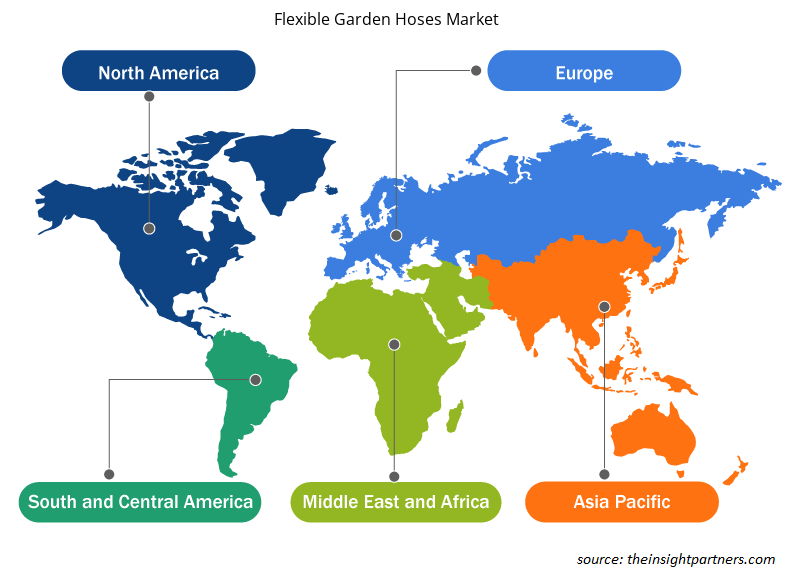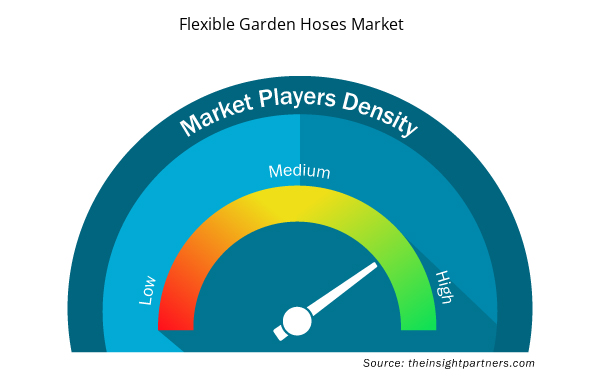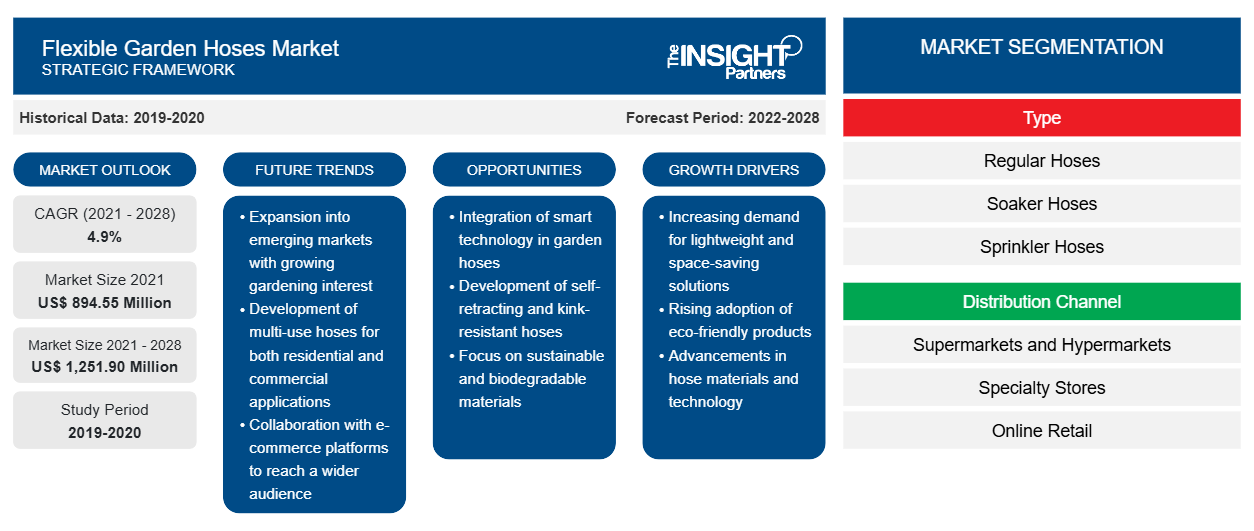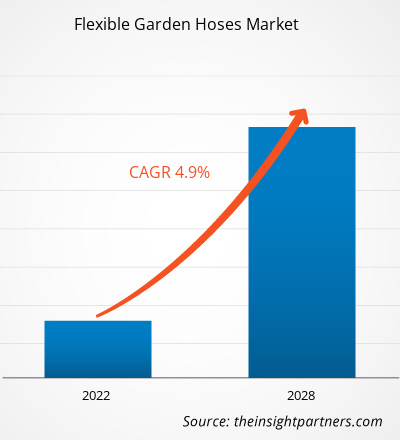柔性花园软管市场预计将从 2021 年的 8.9455 亿美元增长到 2028 年的 12.519 亿美元;预计 2021 年至 2028 年的复合年增长率为 4.9%。
柔性花园软管是传统花园软管的增强版,传统花园软管在花园中通常体积较大,不便于携带。柔性花园软管由坚固的内膜制成,当水充满时,内膜会变大。软管使用时,外盖可保护内膜免受意外刺穿。当水压较高时,柔性花园软管会伸长,当压力释放时,软管会收缩回更紧凑的尺寸。
预计亚太地区的柔性花园软管市场在预测期内将以最高的复合年增长率增长。该地区市场的增长主要归因于工作和老年人口对园艺活动的兴趣日益增加、可支配收入增加以及消费者对园艺活动的认识不断提高等因素。园艺过程现代化的趋势日益增强,推动了整个地区的产品需求。此外,在 COVID-19 危机期间,消费者对园艺活动的倾向日益增加,推动了对园艺用品(如柔性花园软管)的需求。
定制此报告以满足您的需求
您可以免费定制任何报告,包括本报告的部分内容、国家级分析、Excel 数据包,以及为初创企业和大学提供优惠和折扣
- 获取此报告的关键市场趋势。这个免费样品将包括数据分析,从市场趋势到估计和预测。
COVID-19 疫情对柔性花园软管市场的影响
柔性花园软管市场受到可用工人稀缺的严重影响,这阻碍了生产能力。另一方面,由于批发市场关闭,制造商被迫主要依靠超市和电子商务经销商来宣传其柔性花园软管产品,这对其市场需求产生了积极影响。尽管全球疫情肆虐,但柔性花园软管的销量仍出现增长。例如,由于全球 COVID-19 病例不断增加,柔性花园软管在世界各地的受欢迎程度不断提高。自那以后,疫情导致园艺爱好强劲复苏,并提高了人们对家庭花园和清洁空气好处的认识。园艺有助于人们保持身心健康,并缓解与危机相关的压力。此外,在第一波 COVID-19 疫情期间,保持社交距离和居家隔离对于帮助政府拉平感染曲线至关重要,但也引发了人们对可能产生的负面后果的担忧,例如长期隔离或久坐不动的生活方式。在这种情况下,园艺活动被认为是减少居家隔离对心理健康影响的合理工具。
此外,随着全球多个增长市场的开放、疫苗接种的发展以及政府为支持经济和工业增长而采取的举措,预计未来几年对柔性花园软管市场的需求将以积极的速度增长。
市场洞察
园艺活动数量的增加推动了柔性花园软管市场的增长
消费者对园艺活动的兴趣日益浓厚,尤其是在新冠疫情期间,这推动了对园艺用品(如柔性花园软管)的需求。此外,在疫情期间,许多国家和国际组织鼓励人们享受和参与园艺活动,并完成他们的家居装修项目。由于大多数卫生组织要求个人自我隔离,因此人们仍然可以享受一些活动,而无需被关在家里。例如,2020 年 3 月,国家园艺局分享了园丁在疫情期间的工作方式。其中一些方式包括种植菜园、重新设计房子前面的棚架、种植药草园、创建新的室内植物展览以及在大自然中散步,因为这是园丁在放松和自我隔离的同时可以享受的一项活动。此外,2020 年 4 月,Madison Satya Rhodes-Conway 发表了关于社区花园和新冠疫情的声明。为了应对COVID-19疫情,市长建议人们在私人土地和社区花园从事园艺工作,因为这可以成为一种健康的户外活动,并且在疫情期间也是许多园丁必要的食物来源,这将进一步刺激对园艺用品(例如柔性花园软管)的需求。
此外,劳动人口的增加和人们日益增长的城市化压力会增加烦躁、头痛、胃痛、心脏病发作的发生率,并使身体原有的状况恶化。然而,近年来,园艺已成为一种有助于缓解压力的活动。例如,《健康心理学杂志》发表的一项实验将园艺与阅读进行了比较,作为一种缓解压力的活动;与被分配阅读的受试者相比,从事园艺的受试者写作压力减轻幅度更大,因此人们开始参与园艺活动,这也推动了市场的增长。此外,园艺还可以作为改善家庭粮食安全和营养的一种策略。家庭花园也受到了广泛关注。在花园里种植有机食品的人数正在增加,尤其是在发达国家,未来几年可能会对园艺用品产生需求,例如柔性花园软管。因此,园艺活动的增加正在催化柔性花园软管市场的发展。
产品类型洞察
根据产品类型,柔性花园软管市场分为普通软管、浸水软管、喷水软管、可扩展软管和其他软管。2020 年,常规软管部分占据了最大的市场份额,而浸水软管部分预计在预测期内将实现最高的复合年增长率。花园软管通常足够坚固,可以承受刮擦岩石和踩踏而不会泄漏。它们通常由软塑料、橡胶、聚氨酯和其他不同的聚合物制成。花园软管有多种颜色和直径可供选择,具有抗扭结、重量轻和微生物保护等特点。通常,软管的直径范围为 3/8 英寸到 3/4 英寸。此外,花园软管以 25 英尺为增量,总长度范围为 25 至 100 英尺。聚氯乙烯 (PVC) 花园软管是最便宜和最广泛使用的花园软管之一。然而,PVC 软管往往容易扭结并且磨损更快。另一方面,橡胶花园软管不易扭结并且使用方便。此外,聚氨酯花园软管因其耐用性、便利性和灵活性而成为最流行的花园软管之一。花园软管制造商正在推出具有增强功能的新产品。例如,Teknor Apex Company 的 NexFlex 软管配有连接附件,可轻松连接到水龙头或其他水源。这些因素有望为市场上的知名制造商提供竞争优势,超越当地的花园软管制造商。
分销渠道行业洞察
根据分销渠道,柔性花园软管市场细分为超市和大卖场、专卖店、在线零售和其他。专卖店在 2020 年占据了最大的市场份额,而超市和大卖场细分市场预计在预测期内将实现最高的复合年增长率。家装店、DIY 店、五金店和园艺店是花园软管专卖店的几个例子。Home Depot、Lowe's、Gardener's Edge、Fleet Farm、Canadian Tree 是美国和加拿大的主要专卖店,提供各种品牌和类别的花园软管,以满足消费者的特定需求。消费者更喜欢光顾专卖店,因为那里有产品专业知识,而且店内有知识渊博的员工帮助他们选择合适的产品。全球发展中国家和发达国家提供草坪和园艺工具和设备的专卖店数量不断增加,推动了专卖店细分市场的市场增长。
柔性花园软管市场的一些参与者包括 Swan Products LLC、Legacy Manufacturing Company、GARDENA、Fiskars Group、Gilmour、Teknor Apex Company、Briggs & Stratton、Terraflex 和 Craftsman。主要公司采用并购和研发战略来扩大客户群并在全球市场中获得显著份额,这使他们能够在全球范围内保持自己的品牌名称。
柔性花园软管市场区域洞察
Insight Partners 的分析师已详尽解释了预测期内影响柔性花园软管市场的区域趋势和因素。本节还讨论了北美、欧洲、亚太地区、中东和非洲以及南美和中美洲的柔性花园软管市场细分和地理位置。

- 获取柔性花园软管市场的区域特定数据
柔性花园软管市场报告范围
| 报告属性 | 细节 |
|---|---|
| 2021 年市场规模 | 8.9455亿美元 |
| 2028 年市场规模 | 12.519亿美元 |
| 全球复合年增长率(2021 - 2028) | 4.9% |
| 史料 | 2019-2020 |
| 预测期 | 2022-2028 |
| 涵盖的领域 | 按类型
|
| 覆盖地区和国家 | 北美
|
| 市场领导者和主要公司简介 |
|
柔性花园软管市场参与者密度:了解其对业务动态的影响
柔性花园软管市场正在快速增长,这得益于终端用户需求的不断增长,而这些需求又源于消费者偏好的不断变化、技术进步以及对产品优势的认识不断提高等因素。随着需求的增加,企业正在扩大其产品范围,进行创新以满足消费者的需求,并利用新兴趋势,从而进一步推动市场增长。
市场参与者密度是指在特定市场或行业内运营的企业或公司的分布情况。它表明在给定市场空间中,相对于其规模或总市场价值,有多少竞争对手(市场参与者)存在。
在柔性花园软管市场运营的主要公司有:
- 天鹅产品有限公司
- 传统制造公司
- 嘉丁拿
- 菲斯卡斯集团
- 吉尔摩
免责声明:上面列出的公司没有按照任何特定顺序排列。

- 获取柔性花园软管市场顶级关键参与者概述
报告亮点
- 柔性花园软管市场的渐进式行业趋势可帮助参与者制定有效的长期战略
- 发达市场和发展中市场采用的业务增长战略
- 2019 年至 2028 年柔性花园软管市场的定量分析
- 全球柔性花园软管需求量估计
- PEST 分析可说明行业内买家和供应商的效率
- 了解竞争市场状况的最新发展
- 市场趋势和前景以及推动和限制柔性花园软管市场增长的因素
- 通过强调支撑商业利益的市场策略来协助决策过程,从而促进市场增长
- 不同节点的柔性花园软管市场规模
- 市场的详细概述和细分,以及柔性花园软管行业动态
- 各地区柔性花园软管市场规模及增长机遇
柔性花园软管市场(按类型)
- 普通软管
- 渗水软管
- 洒水软管
- 可膨胀软管
- 其他的
柔性花园软管市场、分销渠道
- 超市和大卖场
- 专卖店
- 网上零售
- 其他的
公司简介
- 天鹅产品有限公司
- 传统制造公司
- 嘉丁拿
- 菲斯卡斯集团
- 吉尔摩
- Teknor Apex 公司
- 布里格斯和斯特拉顿
- 泰拉弗莱克斯
- 工匠
- 历史分析(2 年)、基准年、预测(7 年)及复合年增长率
- PEST 和 SWOT 分析
- 市场规模价值/数量 - 全球、区域、国家
- 行业和竞争格局
- Excel 数据集



Report Coverage
Revenue forecast, Company Analysis, Industry landscape, Growth factors, and Trends

Segment Covered
This text is related
to segments covered.

Regional Scope
North America, Europe, Asia Pacific, Middle East & Africa, South & Central America

Country Scope
This text is related
to country scope.
常见问题
Asia Pacific is estimated to register the fastest CAGR in the market over the forecast period The APAC region comprises developed and developing countries such as Australia, China, India, Japan, South Korea, and other Asian countries. The Asia Pacific flexible garden hoses market is primarily driven by its extensive application across agriculture industries. This growth is due to factors like increasing disposable income and growing consumer awareness about gardening activities. The increasing trend of modernization of agricultural processes have increased the product demand across the region. Moreover, increasing consumers’ inclination towards gardening activities, especially amid the Covid-19 crisis, is driving the demand for gardening supplies, including flexible garden hose.
Specialty stores segment is the fastest growing segment in the global flexible garden hoses market during the forecasted period. Specialty stores focus on specific product category and have deep product assortments. These stores provide a personalized shopping experience and a positive retail environment to the customers. They offer value-added products to their customer and focus on customer delight. Moreover, these types of stores usually have trained staff that are knowledgeable about the products they offer. Manufacturers of garden hoses generally concentrate on providing the products through specialty stores as these stores are highly product specific and concentrate on selling products to target customers. Specialty stores for garden hoses include home improvement stores, DIY stores, hardware shops, and gardening stores. The Home Depot, Lowe’s, Gardener’s Edge, Fleet Farm, Canadian Tree are amongst the key specialty stores in the US and Canada that offer garden hoses of various brands and categories that meet the specific requirements of consumers.
Among the five segments of type, regular hoses segment has led the flexible garden hoses market in 2021. They are generally made of soft plastics, rubber, polyurethane, and other different polymers. Garden hoses are available in several colors and diameters, with features including kink resistance, lightweight, and microbial protection. Generally, hoses come in sizes ranging from 3/8-inch to 3/4-inch in diameter. Moreover, garden hoses come in 25-foot increments, with total lengths ranging from 25 to 100 feet. Polyvinyl chloride (PVC) garden hoses are amongst the least expensive and widely available garden hoses. However, PVC hoses tend to kink easily and wear out more quickly. Rubber garden hoses, on the other hand, do not kink easily and are convenient to use. Moreover, polyurethane garden hoses are amongst the highly popular garden hoses owing to their durability, convenience, and flexibility.
A garden hose, often called a hosepipe, is a water-carrying flexible tube used to water gardens and lawns. Regular garden hoses are all-purpose hoses used for watering lawns and home gardens. Hoses usually are connected to a hose spigot or tap. Garden hoses are flexible, and their smooth exterior allows them to be pulled around trees, posts, and other obstructions. Garden hoses are usually strong enough to withstand scraping across rocks and being trodden on without leaking. They are generally made of soft plastics, rubber, polyurethane, and other different polymers. Garden hoses are available in several colors and diameters, with features including kink resistance, lightweight, and microbial protection.
The major players operating in the flexible garden hoses market are Swan Products LLC, Legacy Manufacturing Company, Water Right Inc., GARDENA, Fiskars Group, Gilmour, Teknor Apex Company, Briggs & Stratton, Terraflex, and Craftsman.
In 2021, Europe held the largest revenue share of the global flexible garden hoses market. Covid-19 has caused significant distress around the globe. It has caused considerable damage to public mental health. Since the outbreak of COVID-19 in Europe, levels of stress and anxiety have risen substantially. The rising prevalence of mental illness in Europe has led to an increase in hobbies and recreational activities. Planting and gardening are well-known for being a stress-relieving and anxiety-relieving hobby. Gardening is a great way to relieve stress since it keeps you occupied and requires a lot of mental focus. It also helps to alleviate anxieties about food security while harvesting and distribution of various commodities is slowed by lockdowns. Fruit and vegetable seed sales are on the rise all around the world. The growing gardening activities in Europe derive the demand for gardening tools such as flexible garden hoses.
Trends and growth analysis reports related to Consumer Goods : READ MORE..
The List of Companies - Flexible Garden Hoses Market
- Swan Products LLC
- Legacy Manufacturing Company
- GARDENA
- Fiskars Group
- Gilmour
- Teknor Apex Company
- Briggs & Stratton
- Terraflex
- Flexon Industries
- Craftsman
The Insight Partners performs research in 4 major stages: Data Collection & Secondary Research, Primary Research, Data Analysis and Data Triangulation & Final Review.
- Data Collection and Secondary Research:
As a market research and consulting firm operating from a decade, we have published and advised several client across the globe. First step for any study will start with an assessment of currently available data and insights from existing reports. Further, historical and current market information is collected from Investor Presentations, Annual Reports, SEC Filings, etc., and other information related to company’s performance and market positioning are gathered from Paid Databases (Factiva, Hoovers, and Reuters) and various other publications available in public domain.
Several associations trade associates, technical forums, institutes, societies and organization are accessed to gain technical as well as market related insights through their publications such as research papers, blogs and press releases related to the studies are referred to get cues about the market. Further, white papers, journals, magazines, and other news articles published in last 3 years are scrutinized and analyzed to understand the current market trends.
- Primary Research:
The primarily interview analysis comprise of data obtained from industry participants interview and answers to survey questions gathered by in-house primary team.
For primary research, interviews are conducted with industry experts/CEOs/Marketing Managers/VPs/Subject Matter Experts from both demand and supply side to get a 360-degree view of the market. The primary team conducts several interviews based on the complexity of the markets to understand the various market trends and dynamics which makes research more credible and precise.
A typical research interview fulfils the following functions:
- Provides first-hand information on the market size, market trends, growth trends, competitive landscape, and outlook
- Validates and strengthens in-house secondary research findings
- Develops the analysis team’s expertise and market understanding
Primary research involves email interactions and telephone interviews for each market, category, segment, and sub-segment across geographies. The participants who typically take part in such a process include, but are not limited to:
- Industry participants: VPs, business development managers, market intelligence managers and national sales managers
- Outside experts: Valuation experts, research analysts and key opinion leaders specializing in the electronics and semiconductor industry.
Below is the breakup of our primary respondents by company, designation, and region:

Once we receive the confirmation from primary research sources or primary respondents, we finalize the base year market estimation and forecast the data as per the macroeconomic and microeconomic factors assessed during data collection.
- Data Analysis:
Once data is validated through both secondary as well as primary respondents, we finalize the market estimations by hypothesis formulation and factor analysis at regional and country level.
- Macro-Economic Factor Analysis:
We analyse macroeconomic indicators such the gross domestic product (GDP), increase in the demand for goods and services across industries, technological advancement, regional economic growth, governmental policies, the influence of COVID-19, PEST analysis, and other aspects. This analysis aids in setting benchmarks for various nations/regions and approximating market splits. Additionally, the general trend of the aforementioned components aid in determining the market's development possibilities.
- Country Level Data:
Various factors that are especially aligned to the country are taken into account to determine the market size for a certain area and country, including the presence of vendors, such as headquarters and offices, the country's GDP, demand patterns, and industry growth. To comprehend the market dynamics for the nation, a number of growth variables, inhibitors, application areas, and current market trends are researched. The aforementioned elements aid in determining the country's overall market's growth potential.
- Company Profile:
The “Table of Contents” is formulated by listing and analyzing more than 25 - 30 companies operating in the market ecosystem across geographies. However, we profile only 10 companies as a standard practice in our syndicate reports. These 10 companies comprise leading, emerging, and regional players. Nonetheless, our analysis is not restricted to the 10 listed companies, we also analyze other companies present in the market to develop a holistic view and understand the prevailing trends. The “Company Profiles” section in the report covers key facts, business description, products & services, financial information, SWOT analysis, and key developments. The financial information presented is extracted from the annual reports and official documents of the publicly listed companies. Upon collecting the information for the sections of respective companies, we verify them via various primary sources and then compile the data in respective company profiles. The company level information helps us in deriving the base number as well as in forecasting the market size.
- Developing Base Number:
Aggregation of sales statistics (2020-2022) and macro-economic factor, and other secondary and primary research insights are utilized to arrive at base number and related market shares for 2022. The data gaps are identified in this step and relevant market data is analyzed, collected from paid primary interviews or databases. On finalizing the base year market size, forecasts are developed on the basis of macro-economic, industry and market growth factors and company level analysis.
- Data Triangulation and Final Review:
The market findings and base year market size calculations are validated from supply as well as demand side. Demand side validations are based on macro-economic factor analysis and benchmarks for respective regions and countries. In case of supply side validations, revenues of major companies are estimated (in case not available) based on industry benchmark, approximate number of employees, product portfolio, and primary interviews revenues are gathered. Further revenue from target product/service segment is assessed to avoid overshooting of market statistics. In case of heavy deviations between supply and demand side values, all thes steps are repeated to achieve synchronization.
We follow an iterative model, wherein we share our research findings with Subject Matter Experts (SME’s) and Key Opinion Leaders (KOLs) until consensus view of the market is not formulated – this model negates any drastic deviation in the opinions of experts. Only validated and universally acceptable research findings are quoted in our reports.
We have important check points that we use to validate our research findings – which we call – data triangulation, where we validate the information, we generate from secondary sources with primary interviews and then we re-validate with our internal data bases and Subject matter experts. This comprehensive model enables us to deliver high quality, reliable data in shortest possible time.


 获取此报告的免费样本
获取此报告的免费样本